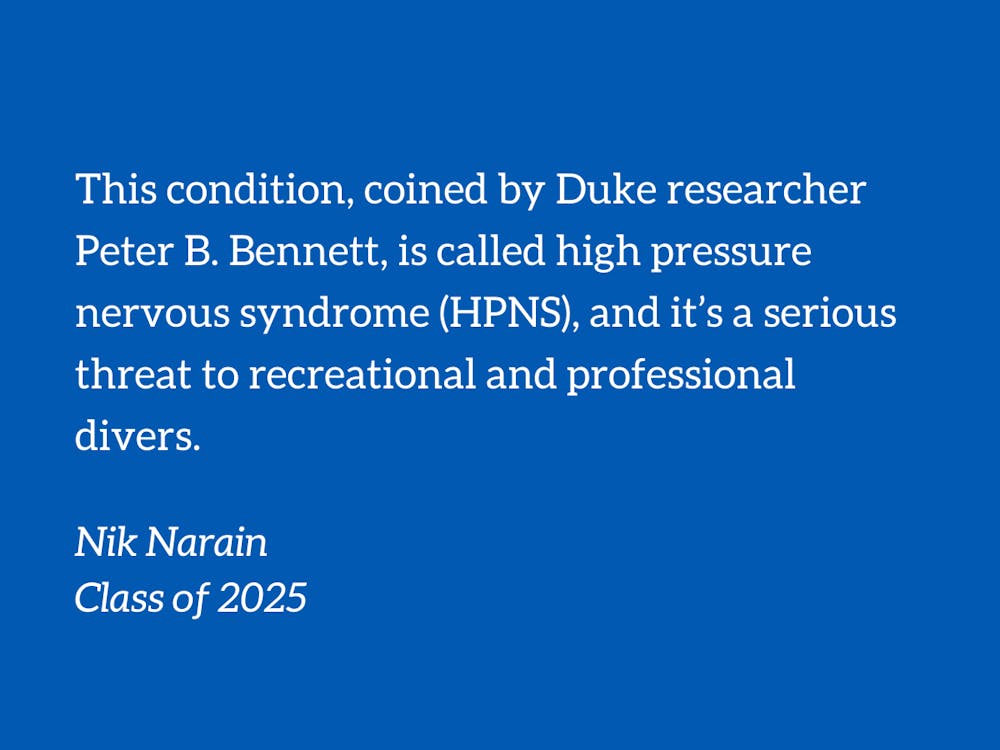If you ever go scuba-diving more than 500 feet into the ocean, chances are you’ll start to feel funny. Headaches, dizziness, vomiting, and even loss of consciousness are all common symptoms for those plummeting into the depths of their despair. This condition, coined by Duke researcher Peter B. Bennett, is called high pressure nervous syndrome (HPNS), and it’s a serious threat to recreational and professional divers.
Naturally, as you go deeper you go into the water, there is more water pushing down on you. With this increase in pressure comes a decrease in the volume of air in your body (shout-out to Boyle’s Law). The result is that your lungs, ears, and sinuses can compress, inevitably leading to problems. Moreover, if you increase your surrounding pressure too fast, your body doesn't have enough time to adapt to its new environment, which can exacerbate the already harmful effects of a high-pressure situation. At least, that’s what my academic counselor told me.
Typically, divers breathe in a combination of helium and oxygen, called heliox, in their compressed air tanks. But, as Bennett discovered, the lack of nitrogen in a diver’s breathing environment may be the culprit for HPNS, as we breathe a good bit of nitrogen while on land. Miraculously, when he and his team added nitrogen to the heliox (you could say, divers-ifying the gas mixture), HPNS symptoms seemed to improve. This addition led to the invention of trimix, a mixture of the three gases, which is now commonly used in commercial diving.
In the late 70s and early 80s, Bennett’s team at the F.G. Hall Laboratory for Environmental Research coordinated four experimental dives in what’s now known as the Atlantis series. This project sought to better understand HPNS when using trimix as the principal respiratory fuel. The project received copious funding from the National Institute of Health, the Navy’s Bureau of Medicine and Surgery, and, of course, Shell Oil.
The study’s volunteers, all experienced divers, were placed in a high-pressure or hyperbaric chamber for 40 days. Picture three dudes in a capsule that kind of looks like the International Space Station but on land, with a dedicated group of specialists on the outside testing their blood, expired gas (from the lungs, you weirdo), and mental state on the daily. And yes, they did eat, sleep, and excrete waste in this hollow tube, the last of which requires a very complicated procedure because a high-pressure toilet flush in a high-pressure nap pod is highly dangerous. What else went on in there is a conversation best left between the divers and God.
By Atlantis II, the team was able to simulate depths of 2,132 feet while keeping participants in “excellent conditions” for physical and psychological performance. By Atlantis III, they went down to 2,250 feet, 63 times normal surface pressure, which set a world record. This was accomplished by Stephen Porter, Erik Kramer, and Len Whitlock who remained at this literal all-time low for four consecutive days. You could say their feat was breath-taking.
Unfortunately, some fishy aftereffects of the study muddied the waters of Bennett’s success. For one, Whitlock began to experience certain problems which he alleged were the result of “permanent organic brain damage” from the dive. Whitlock sued Duke University on account of fraud and intentional infliction of emotional stress, among other claims. However, all claims were eventually denied.
Atlantis IV also ran into problems, mainly due to one volunteer who developed agitation, hyperactivity, racing thoughts, and insomnia at around 2,050 feet. While benzodiazepines successfully controlled these symptoms at that depth, the symptoms returned at 2,132 feet and progressed into a “manialike syndrome” that lasted for two days. For the other divers dealing with the ordeal, the best they could do was diver-t their eyes.
This ultimately prevented the completion of the studies and necessitated early decompression, terminating the Atlantis series as a whole. But Atlantis had already made its impact, not only in setting world records and testing new gas mixtures, but in pioneering the work of surface-based technicians, doctors, and overworked grad students who supported the studies and labored grueling schedules despite very few resources.
Bennett can be best described as a legend in diving research. He was an emeritus professor of anesthesiology at Duke, the executive director of the Undersea and Hyperbaric Medical Society, and the founder/CEO of the Diver’s Alert Network, a global non-profit for diver’s safety. Perhaps most importantly, he was a consultant for James Camerson’s underwater science fiction film The Abyss, which has an 88% on Rotten Tomatoes. Bennett passed away in August 2022 at the age of 91.
If you take anything from this, it’s that you should always scuba dive with proper equipment. Or that you could simulate oceanic conditions about a half mile deep at Duke if you really wanted to (at the Center for Hyperbaric Medicine and Environmental Physiology, which is open 24 hours a day). Or if you place yourself in an extremely high-pressure environment, it’s not long until you develop some significant brain damage. Perhaps, the last one applies to more than deep-sea diving.
Nik Narain is a Trinity sophomore. His columns typically run on alternate Fridays.
Get The Chronicle straight to your inbox
Signup for our weekly newsletter. Cancel at any time.

